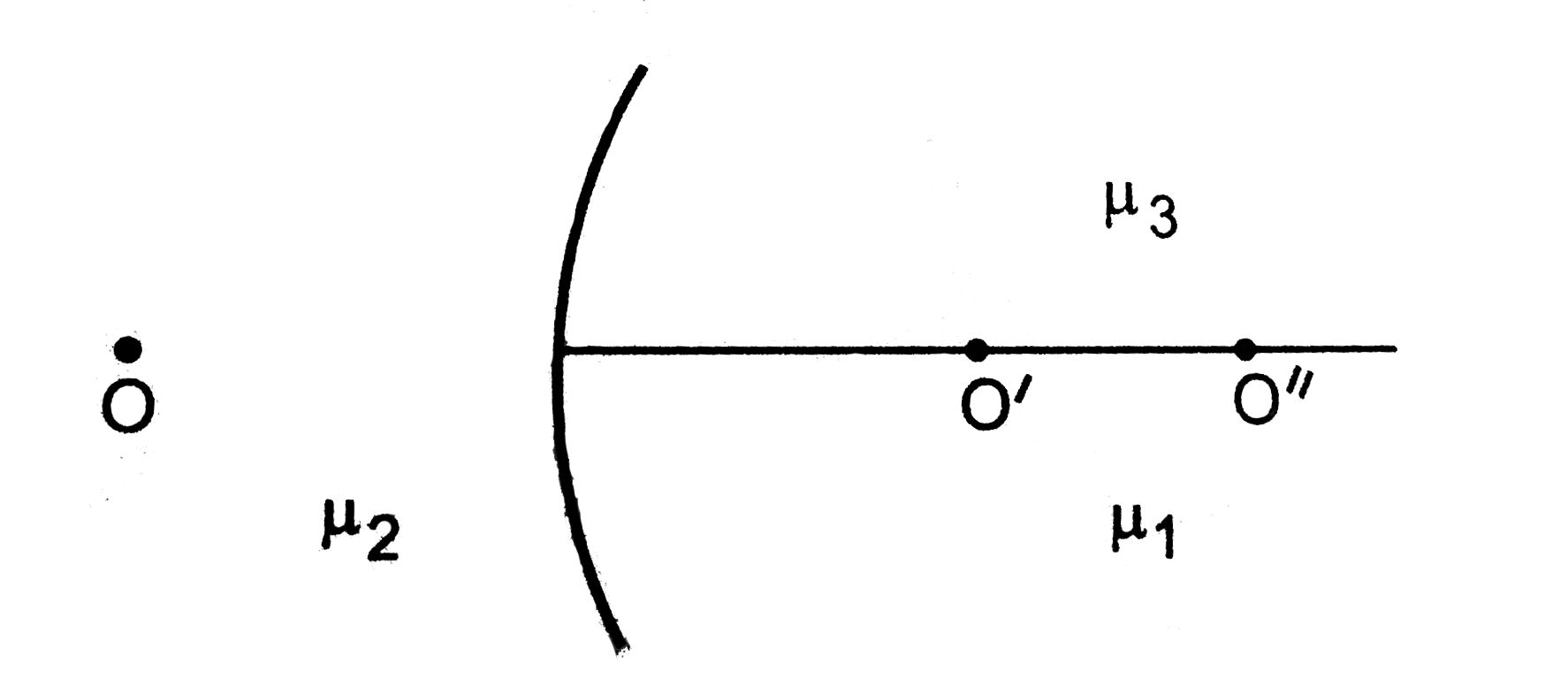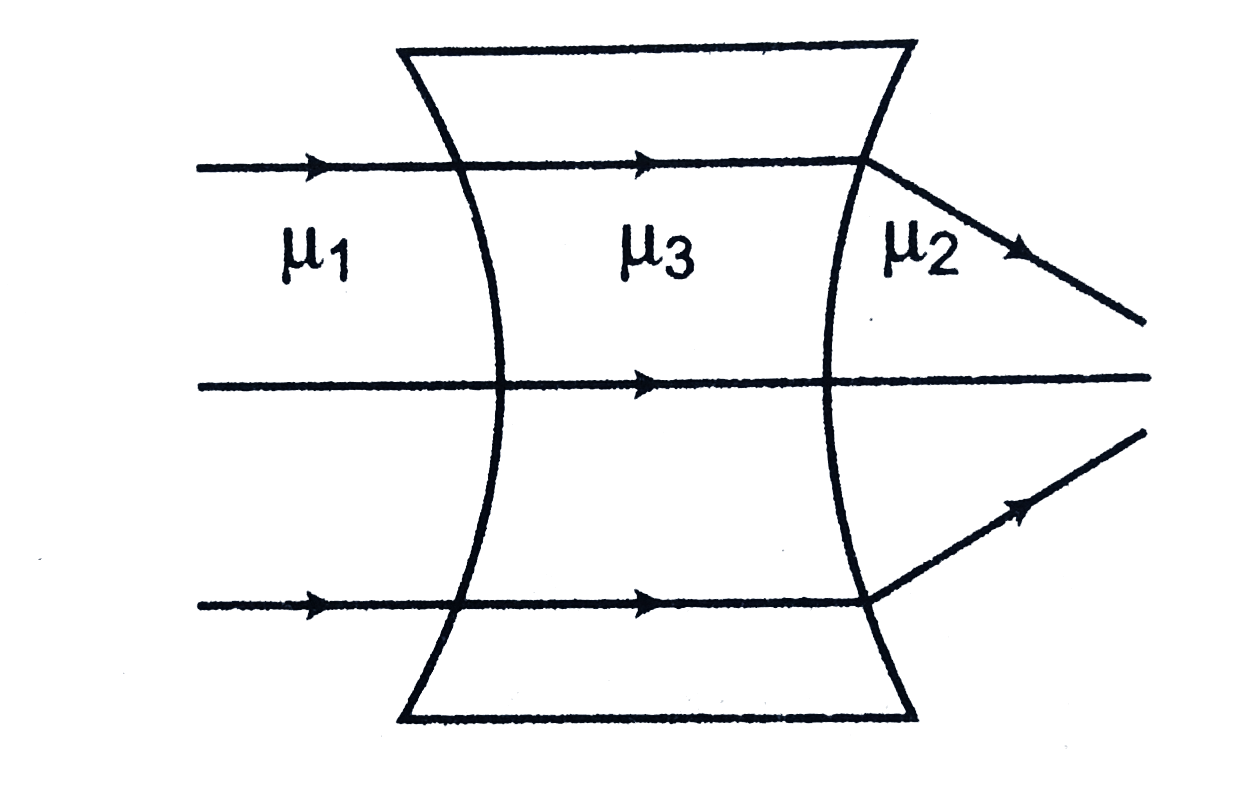उत्तल सतह के लिए दिए गए सूत्र को स्थापित करें : μ2−μ1R=μ2v−μ1u
माना की A एक वस्तु है एवं किरण AM एवं AP अपवर्तित होकत .A. में मिलती है। तब .A. प्रतिबिम्ब है A का। निर्देशांक परिपाटी के अंतर्गत विभिन्न बिन्दुओ के निर्देशांक चित्र में दिखाये गए है। बिंदु बहुत नजदीक है बिंदु P के ,क्यूंकि किरण समाक्षीय है। चित्र की ज्यामिति से
α+r=i
r+β=r
स्नेल के नियम से μ1siniμ2sinr
चूँकि किरणों समाक्षीय है i एंव r छोटे है | अतः μ1l=μ2r
समीकरण (1) एंव (ii) से i एंव r के मान समी o (iii) में डालने पर μ1(α−r)=μ2(rβ)
चित्र में

α≈tanα=MNAN≈MPAP=MPO−u
β≈tanβ=MNA.N≈MPA.P≈MPv−0
γ≈tanr=MNNC≈MPPC=MPR−O
इनके मान रखने पर
μ1=(MP−u+MPR)=μ2(MPR−MPv)
⇒μ1−u+m1R=μ2R−μ2v⇒μ2v−μ1u=μ2R−μ1R
or μ2v−μ1u=μ2−μ1R
चूँकि हमने निर्देशांक उपयोग किया है परिणाम उत्तल एंव अवतल दोनों तालों के लिए उचित चिन्हों के साथ रखने पर मान्य है
Topper's Solved these Questions
- भौतिकी (PHYSICS ) :2020 BOOK - BIHAR BOARD- PREVIOUS YEAR PAPERCHAPTER - भौतिकी (PHYSICS ) :2020 EXERCISE - खण्ड ब (गैर-वस्तुनिष्ठ प्रश्न) लघु उत्तरीय प्रश्न
18 Videos
- भौतिक शास्त्र (ऐच्छिक)BOOK - BIHAR BOARD- PREVIOUS YEAR PAPERCHAPTER - भौतिक शास्त्र (ऐच्छिक)EXERCISE - खंड -ब / दीर्घ उत्तरीय प्रश्न
6 Videos
- भौतिकी (PHYSICS ):2014BOOK - BIHAR BOARD- PREVIOUS YEAR PAPERCHAPTER - भौतिकी (PHYSICS ):2014EXERCISE - खण्ड - घ : दीर्घ उत्तरीय प्रश्न
5 Videos
Similar Questions
कार्बन प्रतिरोध के कलर कोड से आप क्या समझते है ?
View Solutionपतले लेन्स के लिए नीचे दिया हुआ सूत्र स्थापित करें :
1f=(μ−1)(1R1−1R2)
View Solutionसंक्षेप में ट्रांजिस्टर दोलित्र का आधारभूत नियम बताएँ। एक परिपथ चित्र बनाएँ जिसमें प्रेरणिक युग्मन द्वारा पुनर्भरण की प्राप्ति दर्शाई गई हो। दोलित्र अभिक्रिया की व्याख्या करें।
View SolutionThe equation of refraction at a spherical surface is μ2v−μ1u=μ2−μ1R
Taking R=∞, show that this equation leads to the equation
RealdepthApparentdepth=μ2μ1 for fraction at a plane surface.
View SolutionFigure shows figure three transparent medi of refractive indices μ1,μ2andμ3. A point object O is placed in the medium μ2. If the entire medium on the right of the spherical surface has refractive index μ1, the image forms at O. If this entire medium has refractive index μ2 the image form at O''. In the situation shown

View SolutionFrom the figure shown, establish a relation between μ1,μ2,andμ3

View SolutionProve that −μ1u+μ2v=μ2−μ1R when refraction occurs from rarer to denser medium at a concave spherical refracting surface.
View SolutionWhen refraction occurs from denser to……….., then (mu_2)/(mu_1) = …………. .
View SolutionA double convex lens, made from a material of refractive index mu_1 , is immersed in a liquid of refractive index mu_2 , where mu_2 gt mu_1 . What change, if any, would occur in the nature of the lens?
View SolutionProve the following formula when refraction takes place at a convex spherical refracting surface and source of light lies in the rarer medium and image formed is real μ2v−μ1u=μ2−μ1R Where the terms have their usual meanings.
View SolutionStarting new cartesian sign conventions, derive the relation. -frac(mu_1)(u) + frac(mu_2)(v) = frac(mu_2-mu_1)(R) , when refraction occurs from rarer to denser medium at convex spherical refracting surface (mu_1 lt mu_2) . Where u, v and R are object distance, image distance and radius of curvature of spherical surface respectively.
View SolutionA convex lens made of a material of refractive index μ1 , is kept in a medium of refractive index μ2, Parallel rays of light are incident on the lens. Complete the pathof rays of light emerging from the convex lens if μ1=μ2.
View SolutionA convex lens made of a material of refractive index 'mu_1' is kept in a medium of refractive index μ2, Parallel rays of light are incident on the lens. Complete the pathof rays of light emerging fromthe convex lens if μ1<μ2.
View SolutionA convex lens made of a material of refractive index μ1 is kept ih a medium of refractive index μ2, Parallel rays of light are incident on the lens. Complete the path of rays of light emerging fromthe convex lens if μ1>μ2.
View SolutionDerive the relation:- frac(mu_2)(v) - frac(mu_1)(u) = frac(mu_2 - mu_1) (R) when light undergoes refraction fromoptically rarer to optically denser medium at curved surface.
View Solutionदो माध्यमों के अपर्तनांक μ1 और μ2 हैं, उनमें तरंग के वेगों का अनुपात क्या होगा?
View Solution
